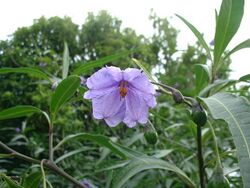Solanum aviculare: Difference between revisions
No edit summary |
No edit summary |
||
| Line 1: | Line 1: | ||
{{Inc| | |||
Solanum aviculare, Forst. (S. laciniatum, Ait.). A leafy unarmed soft-wooded glabrous shrub 4-8 ft. high, with spreading branches, smooth or marked with raised lines decurrent from the petioles: lvs. variable in size and shape, 4-12 in. long or sometimes even longer, lanceolate or linear-lanceolate, entire or irregularly pinnatifid and the lobes linear or lanceolate and acute: fls. in cymose clusters in the axils of the upper lvs. or lateral; calyx-lobes broad and obtuse, with an abrupt point; corolla violet, 3/4-l in. diam., the lobes short and broad: fr. a broad ovoid edible berry 3/4-l in. long, yellowish. New Zeal.; also common in many parts of Austral., Tasmania, and in Norfolk Isl. B. M. 349. | |||
}} | |||
{{Taxobox | {{Taxobox | ||
| color = lightgreen | | color = lightgreen | ||
Revision as of 17:51, 14 July 2009
| Standard Cyclopedia of Horticulture |
|---|
|
Solanum aviculare, Forst. (S. laciniatum, Ait.). A leafy unarmed soft-wooded glabrous shrub 4-8 ft. high, with spreading branches, smooth or marked with raised lines decurrent from the petioles: lvs. variable in size and shape, 4-12 in. long or sometimes even longer, lanceolate or linear-lanceolate, entire or irregularly pinnatifid and the lobes linear or lanceolate and acute: fls. in cymose clusters in the axils of the upper lvs. or lateral; calyx-lobes broad and obtuse, with an abrupt point; corolla violet, 3/4-l in. diam., the lobes short and broad: fr. a broad ovoid edible berry 3/4-l in. long, yellowish. New Zeal.; also common in many parts of Austral., Tasmania, and in Norfolk Isl. B. M. 349.
|
| Poroporo {{{status}}} Fossil range: {{{fossil_range}}}
| ||||||||||||||||||||||||||||||||||||||||||||||||||||||||||||||||||
|---|---|---|---|---|---|---|---|---|---|---|---|---|---|---|---|---|---|---|---|---|---|---|---|---|---|---|---|---|---|---|---|---|---|---|---|---|---|---|---|---|---|---|---|---|---|---|---|---|---|---|---|---|---|---|---|---|---|---|---|---|---|---|---|---|---|---|
 Poroporo | ||||||||||||||||||||||||||||||||||||||||||||||||||||||||||||||||||
| Plant Info | ||||||||||||||||||||||||||||||||||||||||||||||||||||||||||||||||||
| ||||||||||||||||||||||||||||||||||||||||||||||||||||||||||||||||||
| Scientific classification | ||||||||||||||||||||||||||||||||||||||||||||||||||||||||||||||||||
| ||||||||||||||||||||||||||||||||||||||||||||||||||||||||||||||||||
| [[{{{diversity_link}}}|Diversity]] | ||||||||||||||||||||||||||||||||||||||||||||||||||||||||||||||||||
| {{{diversity}}} | ||||||||||||||||||||||||||||||||||||||||||||||||||||||||||||||||||
| Binomial name | ||||||||||||||||||||||||||||||||||||||||||||||||||||||||||||||||||
| Solanum aviculare Forst | ||||||||||||||||||||||||||||||||||||||||||||||||||||||||||||||||||
| Trinomial name | ||||||||||||||||||||||||||||||||||||||||||||||||||||||||||||||||||
| {{{trinomial}}} | ||||||||||||||||||||||||||||||||||||||||||||||||||||||||||||||||||
| Type Species | ||||||||||||||||||||||||||||||||||||||||||||||||||||||||||||||||||
| {{{type_species}}} | ||||||||||||||||||||||||||||||||||||||||||||||||||||||||||||||||||
| {{{subdivision_ranks}}} | ||||||||||||||||||||||||||||||||||||||||||||||||||||||||||||||||||
| [[Image:{{{range_map}}}|{{{range_map_width}}}|]] | ||||||||||||||||||||||||||||||||||||||||||||||||||||||||||||||||||
| Synonyms | ||||||||||||||||||||||||||||||||||||||||||||||||||||||||||||||||||
| {{{synonyms}}} |
Poroporo (Solanum aviculare and S. laciniatum), also called Kangaroo Apple, is a soft-wooded plant and one of three nightshades native to New Zealand and the eastern coast of Australia. It's an evergreen shrub that can grow up to 12 feet tall (4 meters). Its hermaphroditic (having both male and female organs) flowers are white to mauve and yield to poisonous berries. The berries, once ripened, are no longer poisonous.
The leaves and unripe fruit of the poroporo are poisonous and only the ripe berries can be safely eaten. The plant is also used in the manufacture of some contraceptive pills. The plant is also used as a rootstock for grafting eggplant.
There is some uncertainty whether S. aviculare and S. laciniatum are actually the same plant. While they may be varieties of the same species, S. aviculare has lighter flowers and is found in the northern part of the North Island of New Zealand, while S. laciniatum has darker purple flowers and is found south of Auckland.
External links
- Plants of New Zealand S. aviculare